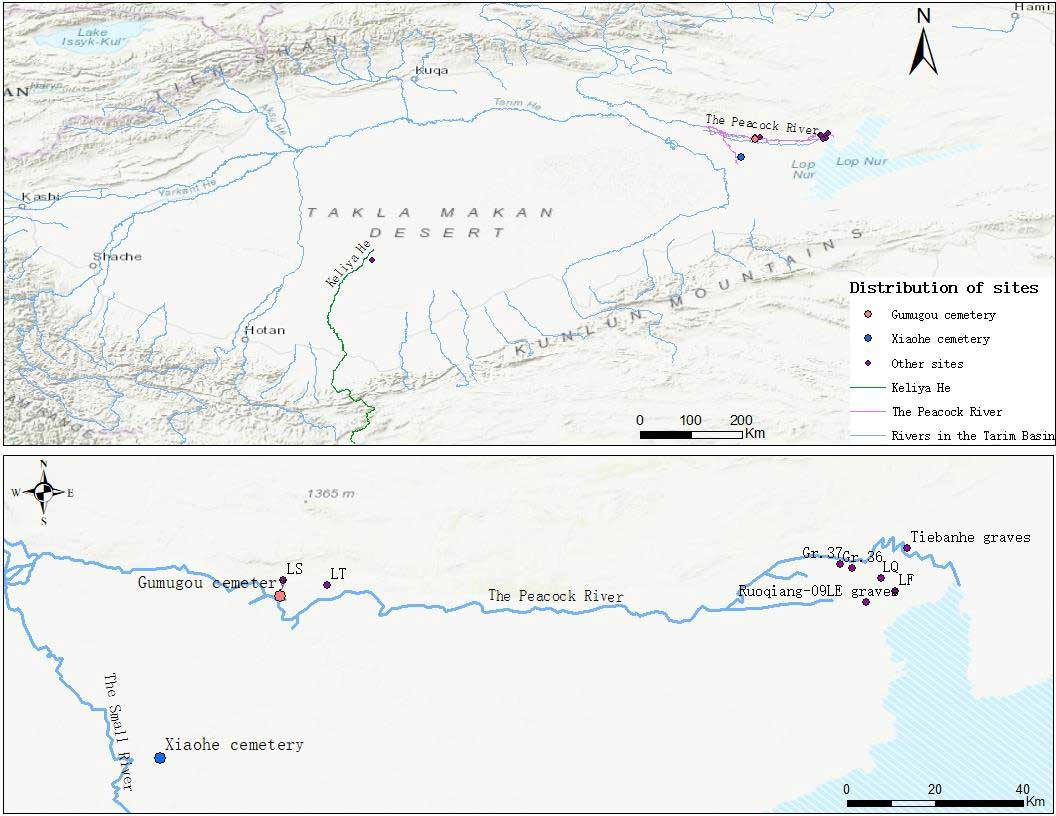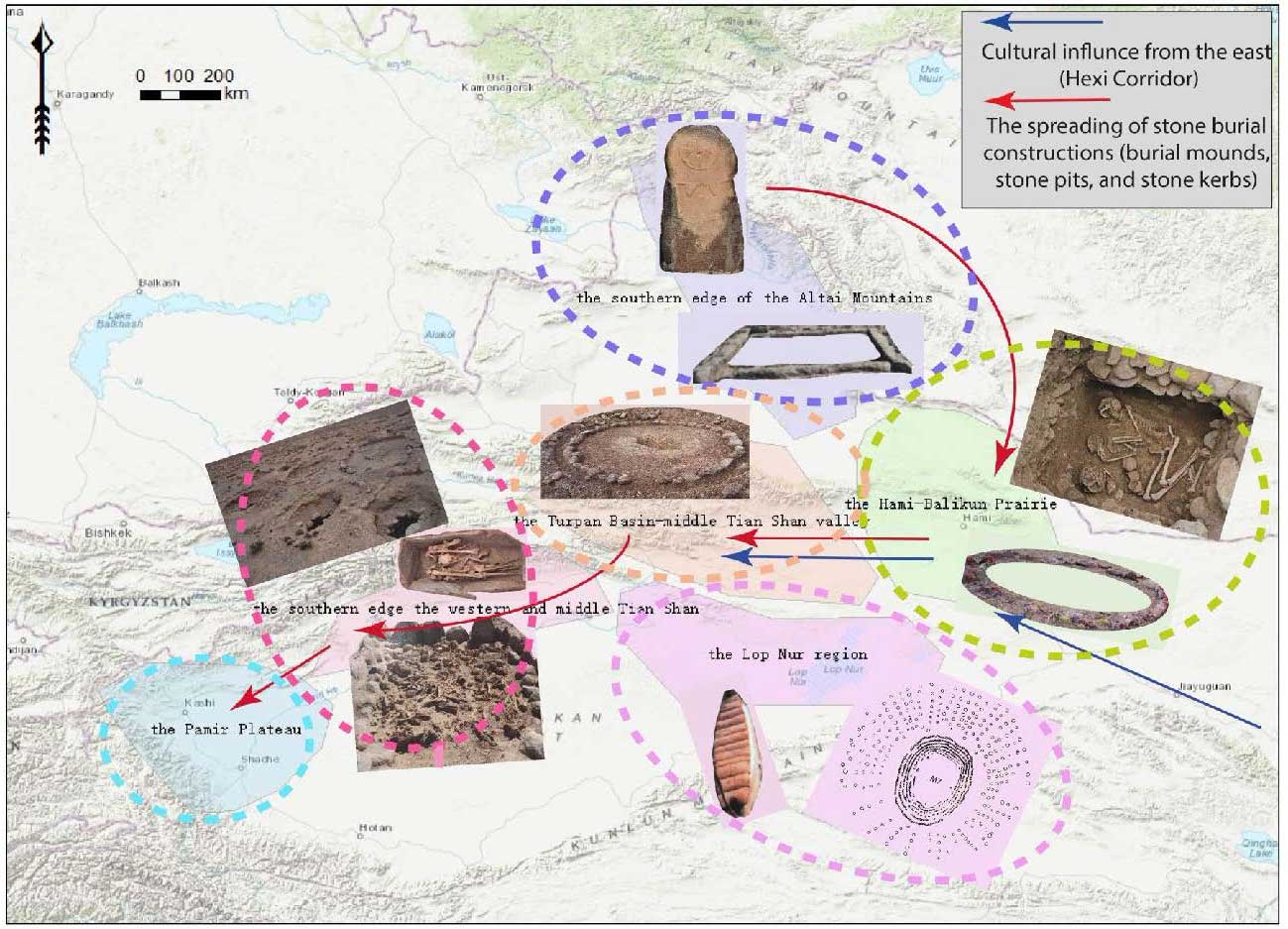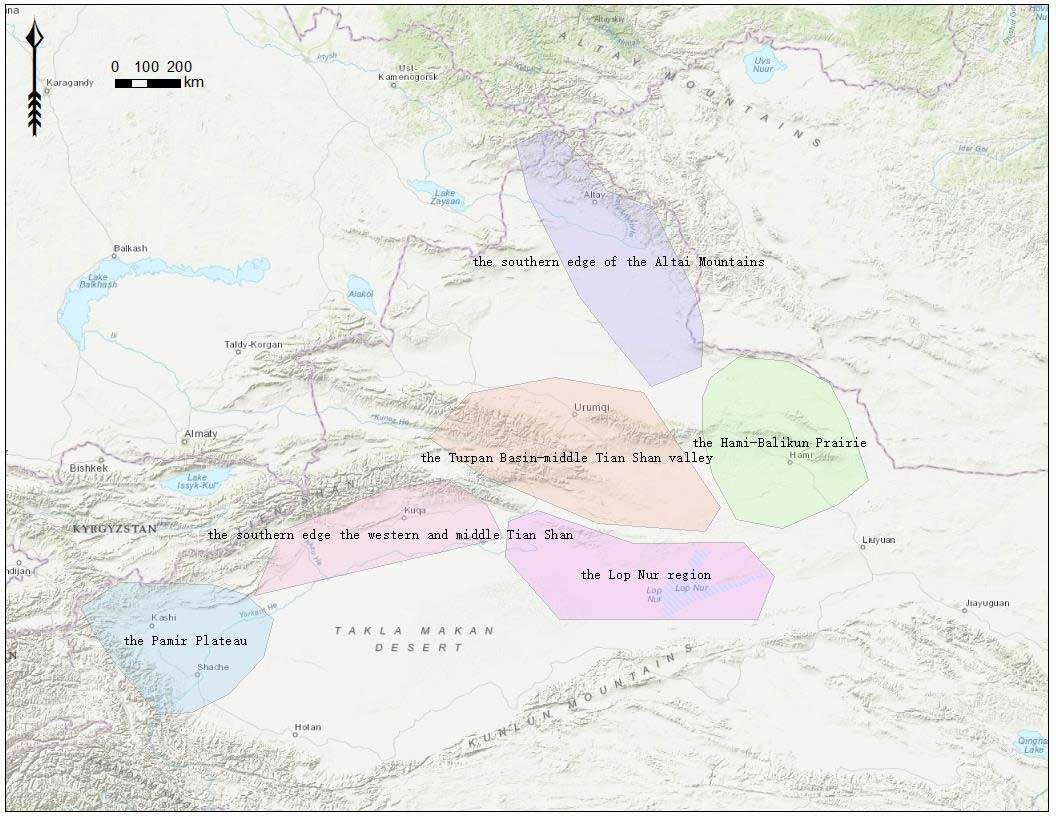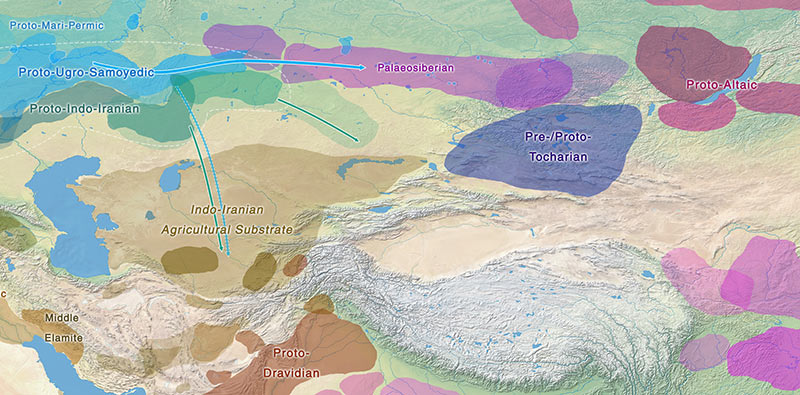Master’s thesis Shifting Memories: Burial Practices and Cultural Interaction in Bronze Age China: A study of the Xiaohe-Gumugou cemeteries in the Tarim Basin, by Yunyun Yang, Uppsala University, Department of Archaeology and Ancient History (2019).
Summary excerpts, mainly from the conclusions (emphasis mine):
Both the Xiaohe and the Gumugou groups are suggested as possibly originating from southern Siberia or Central Asia and being related to Afanasievo and Andronovo people (Han 1986, 1994; Li et al. 2010, 2015). But a latest research suggest that the Xiaohe males are genetic distinct from the Afanasievo males, considering the paternal lineages (Hollard et al. 2018). From genetic evidence, it is suggested that southern Siberia and Central Asia were dominated by Europeans during the Bronze Age. Southern Siberia was predominant by Europeans since the Bronze Age as a result of eastward migration of Kurgan people (Keyser et al. 2009). Central Asia started to have an eastern Eurasian maternal lineage that coexisted with the previous western maternal lineage from around 700 BCE (Lalueza-Fox et al. 2004). Based on the research mentioned above, we can conclude as that the Xiaohe and the Gumugou people possibly came from the southern Siberia or Central Asia.
Origin of the Xiaohe horizon
There are two hypotheses about the origins of the Xiaohe horizon. The “steppe hypothesis” assumes that the early settlers (Gumugou people) of the Tarim Basin came from the Afanasievo culture in the Minusinsk Basin-Altai Mountains regions (Kuz’mina et al. 2008; Mallory et al. 2008). The “oasis hypothesis” argues that the early settlers were related to the spreading of the oasis-based agricultural groups from the Bactria and Margiana parts of the southern Central Asia area (Chen et al. 1995). Both hypotheses mainly relied on the use of some materials such as animal cattle, sheep/goats, camel hair, and plant wheat, whose origins were bound to western traditions. But these proofs cannot provide enough support to claim that the Xiaohe horizon cultures were from Afanasievo or BMAC cultures, except for telling there were possible cultural connections or interactions among them. What’s more, there were no horses or potteries in the Xiaohe horizon.
It is worth noting that Ephedra plant is commonly thought as a strong candidate of the Soma or Haoma sacred drink for the ancient Indians or Iranians. Soma is the name recorded in the Vedic Brahmanism religious literature Rigveda, Haoma in the Zoroastrianism Avesta, and indicates as a ritual drink from plant juice. The reason to address Ephedra plant to Soma-Haoma drink is mainly because of its ephedrine, which works on muscle strength, low blood pressure, (and asthma) to make people get rid of tiredness (Houben 2013). Furthermore, it is thought that Ephedra with anti-fatigue function gives gods or the dead immortality, longevity, and resurrection (Mahdihassan 1987). From a mobile consideration of Vedic Aryans perspective, it is thought Vedic Aryans made use of Ephedra, cannabis and poppy to produce Soma drink in Margiana, only Ephedra in Bactria and in Indian mountains area, but other substitutes in Indian plains (Shah 2014). From the Ephedra perspective, it is agreeable that the Xiaohe-Gumugou people were related to the Indo-Aryan peoples (Mallory et al. 1997; Wang 2017).

Burial customs
Both the Xiaohe and the Gumugou groups maintained similar burial customs, but we can distinguish a developing process from the slight diverse ways of the Gumugou cemetery to the highly consistent and advanced technology in making coffins of the Xiaohe cemetery. In terms of the dressing, the dead wore a felt cap, a pair of leather boots, a bracelet twined on the right wrist, and was wrapped in a big felt mantle. The dead in the Xiaohe cemetery also wore a loin-cloth. Commonly, both cemeteries contained burials goods of Ephedra twigs, grains of wheat and millet, grass-made baskets, animal ears (such as calf ears), and livestock. Wooden coffins in the two cemeteries were constructed in a similar way, by assembling two side-planks, two end-boards, a lid consisting of a few short straight boards, and covered with livestock hide (mainly cattle hide in the Xiaohe cemetery and sheep/goats hide in the Gumugou cemetery).
Considering the similar and continuous burial behaviours in the two cemeteries, it can be assumed that both the Xiaohe and the Gumugou societies were stable and consistent. The Xiaohe cemetery had both the special clay-lid wooden coffins and the normal coffins in its early phase (burial layers 4th-5th), then turned to be stable and consistent with the normal coffins (burial layers 1st-3rd), and have developed better construction of the boat-shape coffins. The Gumugou cemetery contained two main burial patterns, type I; the sun-radiating-spokes burials and type II; the normal burials, which coexisted during the same time. Burials of type II were similar but not limited to strict rules. Burials in both the Xiaohe and the Gumugou cemetery were fairly heterogeneous, and the clay-lid wooden coffins in the Xiaohe cemetery and the sun-radiating-spokes burials in the Gumugou cemetery only took up in a small percentage of each cemetery. These special burial types could indicate special roles of the dead in their related societies. Either the dead had high social positions or possibly they actually had a different ancestry origin. It is argued here that the latter is something that is quite possible, considering the mixed populations in the two cemeteries.
The sun-radiating-spokes burials share some features with a similar type of grave, constructed of circular stone kerbs of the stone-pit graves. The sun-radiating-spokes burials might represent an adaption to the local desert environment, which had better access to wood rather than stones. Circular stone kerbs with stone-pit in centre were widely seen in Bronze Age Afanasievo and Andronovo burials, and also in the late Bronze Age and early Iron Age burials along the Tian Shan. The present study suggests a high possibility that the six males buried in the sun-radiating-spokes graves came from the contemporary parallel Andronovo horizon, and kept some of their own ancestry memories in an adapted way.

Societies
Although the Xiaohe and Gumugou societies were stable and consistent, it does not mean that the societies were isolated, and we can see strong indications of them being open to the outside. With time, the Xiaohe population were getting even more diverse origins, as newcomers kept joining the group from outside. However, the burial behaviours in the Xiaohe cemetery did not change as a consequence if these additions. This suggests that the newcomers inherited the local burial customs, and strongly indicates that they became part of the community and adopted the new social identity, possibly through marriage. As a result, the diverse populations can well explain the coexistence of different cultural elements in the burials, e.g. cattle, sheep/goats, camel hair (from Central Asia), grains of wheat (from the west) and millet (from the east), etc.
The Xiaohe and the Gumugou societies were similar, but the Xiaohe society developed to a more advanced level both in economy and in social structure. First, the oasis-based economic system of the Xiaohe and the Gumugou had similar husbandry, but later this was developed to different extent. Both societies mainly relied on livestock, and while the Xiaohe people favoured cattle, the Gumugou people favoured sheep/goats. The two societies also developed agriculture, which can be seen from the grains of wheat and millet. It has been shown that grains of wheat are bread wheat. The Xiaohe people also cooked porridge with millet and milk, and had dairy products.
From these evidences, we can assume that the Xiaohe people have developed a stronger economic level. Secondly, the Xiaohe society had more distinguished gender roles, resulting in different social roles for men and women in terms of work and religions. The female and male dead were buried in a distinguished way with loin-cloths and wooden monuments. Sexual identity on a social level refers to how people consider and expect different genders to act and behave under the social and cultural framework. In the Xiaohe society, men carried out hunting tasks (creatures like vultures, badgers, lizards, snakes); women were associated to the rebirth of lives. To synthesize, a possible relation between the Xiaohe and the Gumugou societies is that they represent two parallel groups who shared similar economic systems because of the similar environment, or that there is a chronological difference where the Gumugou people may have existed earlier. The absolute dating information from the two cemeteries is insufficient to rule out the second situation.

Surroundings
To place the Xiaohe horizon in the larger context of the Bronze Age burials in its surroundings, the hypothesis presented in this study is that the Xiaohe-Gumugou people might possibly represent a parallel to the Andronovo groups, with an eastward migration, that developed their own societies and ethnicities in the Tarim Basin with some ancestral memories still preserved. Considering the location and the geographical features of Xinjiang, the Altai Mountains and the Tian Shan left open access from the Eurasian Steppe to the Dzungarian Basin. The Hami Basin-the Balikun Grassland was the first intersection area to combine the possible western and eastern cultural influences. To pass by the Turpan Basin and enter into the Tarim Basin, there were two possible routes, one northern route along the southern edge of Tian Shan, and one southern route along the northern edge of Kunlun Mountains.
In the early Bronze Age, the burials in Xinjiang had some clear typical geographic features that distinguish them from their surroundings. But from the late Bronze Age to the early Iron Age, the tradition with circular kerbs of stones with stone-pits burials expanded along the southern edge of the Tian Shan, which was a major shift of burial practice that possibly could be linked to the expansion of the Andronovo horizon or a general nomadic expansion.
Although there were no horses or wagons found in the Xiaohe burials, the wooden horse-hoof objects were an indication of horses, which did not exist in their daily lives anymore, but possibly were related to some settlers’ ancestral memories of their nomadic origins. However, it was more important for them to assimilate to the common social identities of their new group. After people died, it was preferred to be buried in the communal cemetery. Even if the dead bodies were lost, wooden substitutes will be used in graves to represent the dead, since they believed in afterlife and thought that the end of the death is rebirth.
Comments
While the results of Li et al. (2010, 2015) of Xiaohe mummies regarding Y-chromosome haplogroups – showing mostly R1a(xZ93) – and radiocarbon dates of the samples are yet to be confirmed, Proto-Tocharians are known to have had contacts with Samoyeds, early Indo-Iranians (in turn in contact with the BMAC language), then into Common Tocharian with ancient Iranians, and then Indo-Aryan and Iranian languages again (for more on this, see Ged Carling‘s publications).
The connection of the Tocharian branch with Afanasevo is essentially indisputable today, like that of Late Proto-Indo-European with late Repin/early Yamna, even more so than it was just 10 years ago, thanks to the most recent genetic investigation. The common genetic stock of Yamna and Afanasevo – as well as that of East Bell Beakers and Palaeo-Balkan peoples – fits perfectly earlier predictions based on the linguistic estimates of the separation and evolution of the diverse language communities, and the tentative attribution to Eurasian steppe-related cultures.

The trail leading from Afanasevo to Common Tocharians, on the other hand, seems to be more tricky, not unlike many other Indo-European-speaking groups from Europe and Asia, whose precise evolution until their historical attestation is often unclear. Nevertheless, the eventual presence of diverse haplogroups among historical Tocharians – whether they coincide with ancient DNA recovered from BMAC, South India, Andronovo, or Bronze Age Tian Shan populations – will only be relevant to understand the genetic evolution of the speakers of Tocharian during its different stages.
If the genetic trail backwards from known Tocharians to (earlier) unknown Common Tocharians, and forwards from known Pre-Tocharians to (later) unknown Proto-Tocharians leads unequivocally to these populations from the Xiaohe cultural horizon, this paper shows one of the mechanisms through which peoples of the Andronovo cultural horizon (or, more precisely, male lines derived from it) may have become integrated into a Tocharian-speaking population, not dissimilar to what happened in the steppes between Uralic-speaking Abashevo and Pre-Proto-Indo-Iranian-speaking Catacomb-Poltavka to form the Proto-Indo-Iranian-speaking Sintashta-Potapovka-Filatovka culture.
As we have discussed in this blog many times over, to solve this ethnolinguistic identification of prehistoric cultures one needs to investigate ancient DNA in combination with linguistic guesstimates and the Indo-European homeland problem from a wide anthropological perspective. People not understanding this simple concept are bound to end up in some comical Tocharo-Indo-Iranian grouping related to Corded Ware ancestry from Andronovo, similar to the Celto-Ibero-Basques of elevated CEU BA ancestry and hg. R1b-P312 to the south of the Pyrenees during the Iron Age from Olalde et al. (2019), and to the Balto-Finno-Slavs of hg. R1a-Z283 and elevated “Steppe ancestry” in the BA-IA East Baltic from Saag et al. (2019)…
Related
- A study of genetic diversity of three isolated populations in Xinjiang using Y-SNP
- Aquitanians and Iberians of haplogroup R1b are exactly like Indo-Iranians and Balto-Slavs of haplogroup R1a
- Consequences of Damgaard et al. 2018 (II): The late Khvalynsk migration waves with R1b-L23 lineages
- The origin of social complexity in the development of the Sintashta culture
- Sintashta diet and economy based on domesticated animal products and wild resources
- The genetic and cultural barrier of the Pontic-Caspian steppe – forest-steppe ecotone
- Steppe and Caucasus Eneolithic: the new keystones of the EHG-CHG-ANE ancestry in steppe groups
- On the origin of haplogroup R1b-L51 in late Repin / early Yamna settlers
- On the origin and spread of haplogroup R1a-Z645 from eastern Europe
- Kurgan origins and expansion with Khvalynsk-Novodanilovka chieftains
- About Scepters, Horses, and War: on Khvalynsk migrants in the Caucasus and the Danube
- North Pontic steppe Eneolithic cultures, and an alternative Indo-Slavonic model